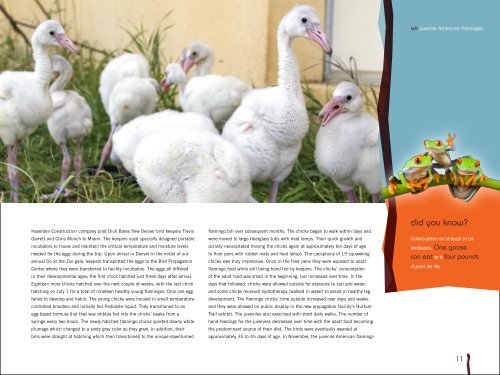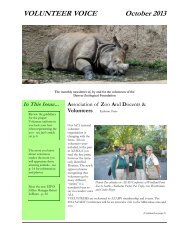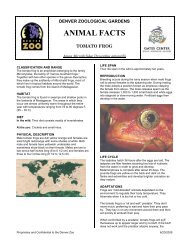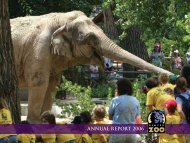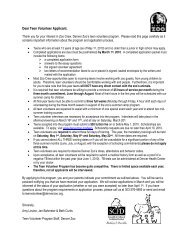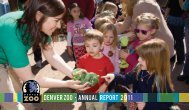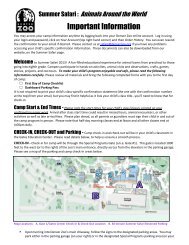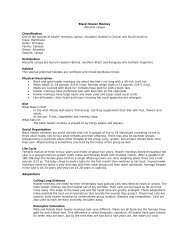2008 Annual Report - Denver Zoo
2008 Annual Report - Denver Zoo
2008 Annual Report - Denver Zoo
- No tags were found...
You also want an ePaper? Increase the reach of your titles
YUMPU automatically turns print PDFs into web optimized ePapers that Google loves.
left juvenile American flamingosHaselden Construction company pilot Dick Bares flew <strong>Denver</strong> bird keepers TravisGarrett and Chris Munch to Miami. The keepers used specially designed portableincubators to house and maintain the critical temperature and moisture levelsneeded for the eggs during the trip. Upon arrival in <strong>Denver</strong> in the midst of ourannual Do at the <strong>Zoo</strong> gala, keepers transported the eggs to the Bird PropagationCenter where they were transferred to facility incubators. The eggs all differedin their developmental ages; the first chick hatched just three days after arrival.Eighteen more chicks hatched over the next couple of weeks, with the last chickhatching on July 1 for a total of nineteen healthy young flamingos. Only one eggfailed to develop and hatch. The young chicks were housed in small temperaturecontrolledbrooders and initially fed Pedialyte liquid. They transitioned to anegg-based formula diet that was dribble fed into the chicks’ beaks from asyringe every two hours. The newly hatched flamingo chicks sported downy whiteplumage which changed to a sooty gray color as they grew. In addition, theirbills were straight at hatching which then transitioned to the unique downturnedflamingo bill over subsequent months. The chicks began to walk within days andwere moved to large fiberglass tubs with heat lamps. Their quick growth andactivity necessitated moving the chicks again at approximately ten days of ageto floor pens with rubber mats and heat lamps. The cacophony of 19 squawkingchicks was truly impressive. Once in the floor pens they were exposed to adultflamingo food while still being hand fed by keepers. The chicks’ consumptionof the adult food was small in the beginning, but increased over time. In thedays that followed, chicks were allowed outside for exposure to sun and water;and some chicks received hydrotherapy (walked in water) to assist in healthy legdevelopment. The flamingo chicks’ time outside increased over days and weeksand they were allowed on public display in the new propagation facility’s NurtureTrail exhibit. The juveniles also exercised with short daily walks. The number ofhand-feedings for the juveniles decreased over time with the adult food becomingthe predominant source of their diet. The birds were eventually weaned atapproximately 35 to 45 days of age. In November, the juvenile American flamingodid you know?Canada geese can be tough on zoolandscapes. One goosecan eat up to four poundsof grass per day.11


